The Seagate NAS line is a 2 or 4-bay NAS designed for SOHO users and small businesses without dedicated IT resources. The Seagate NAS comes with a Marvell 1.2GHz processor, 512MB of DDR3 ram, and can run up to 20TB in capacity. The NAS also comes with Seagate’s new operating system, NAS OS 4 and ships with Seagate 5TB NAS HDDs. Having all of the software, hardware, and drives made by Seagate enables the system to work together seamlessly. The NAS come preconfigured to save setup time but users can change the configuration through SimpleRAID technology built into the OS.
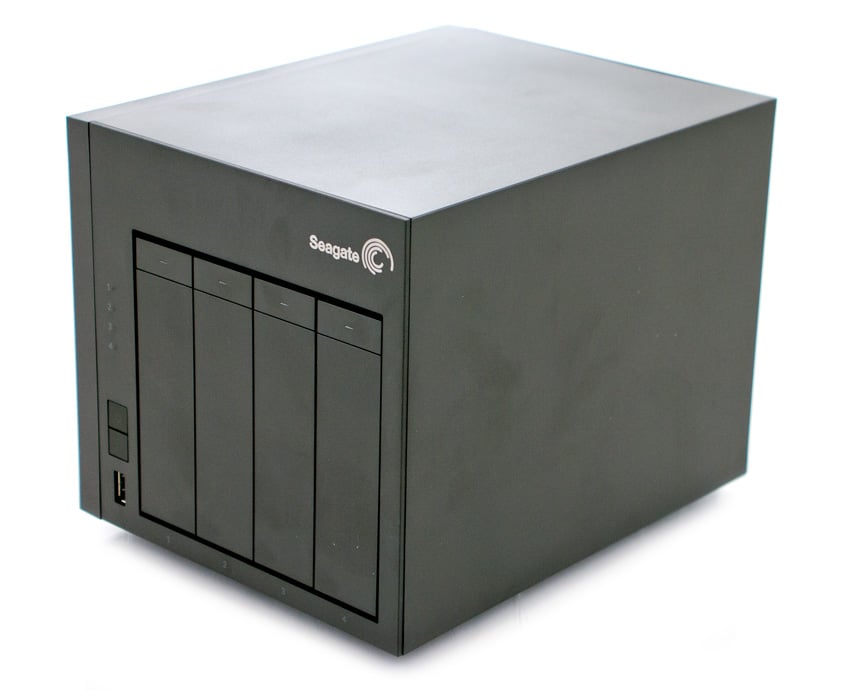
NAS OS 4 has a redesigned Device Manager to allow effortless management of data. Its App Manager and Sdrive allow for remote access, so the user’s data is always available and can be accessed on any platform. The device creates a private cloud that physically resides on Seagate NAS, keeping files centrally located while allowing access for clients and partners. NAS OS 4 is thanks in large part to LaCie design team (that has now fully integrated with Seagate). The new operating system is an easy-to-use and intuitive OS. It is a web-based interface that simplifies setup and management and is designed specifically for the Seagate NAS line.
The Seagate 4-bay NAS comes with a 3-year warranty and starts at a street price of $300 with no drives.
Seagate NAS specifications:
- Models and total capacities:
- 2-bay: up to 10TB (2 x 5TB)
- 4-bay: up to 20TB (4 x 5TB)
- Form Factor: Small desktop
- CPU frequency: 1.2GHz (Marvell 370)
- Memory: 512MB DDRIII
- Interface: Gigabit Ethernet
- External Ports:
- 2 x USB 3.0
- 2 x 10/100/1000 Base-TX
- Hot-swappable HDD trays
- Physical Dimensions (2-bay/4-bay):
- Height: 6.69”/6.69”
- Width: 4.72”/6.85”
- Depth: 8.58”/8.58"
- Weight: 3.86lbs./5.4lbs
- Environmental Specifications:
- Operating: 0 to 40°C
- Non-operating: -40 to 65°C
- Relative Humidity, Operating/Nonoperating (non-condensing, %): 0 to 80/0 to 95
- Power Consumption(2-bay x 2 HDD/4-bay x 4HDD):
- Operation mode: 16W/32W
- Power-saving mode: 7W/13W
- WOL mode: 0.55W/0.95W
- Operating system: NAS OS 4 (embedded Linux)
- 3-year warranty
Design and build
The Seagate NAS is a small desktop form factor. It is all black with sharp angles. What looks like metal, on closer inspection is all plastic. The unit still looks nice and feels good and sturdy though. The hot-swappable drives are easily accessed through the front of the device. The power and backup buttons are also on the front on the lower left hand side, with a USB 3.0 port underneath and LED indicator lights above. On the upper right hand is the Seagate branding.
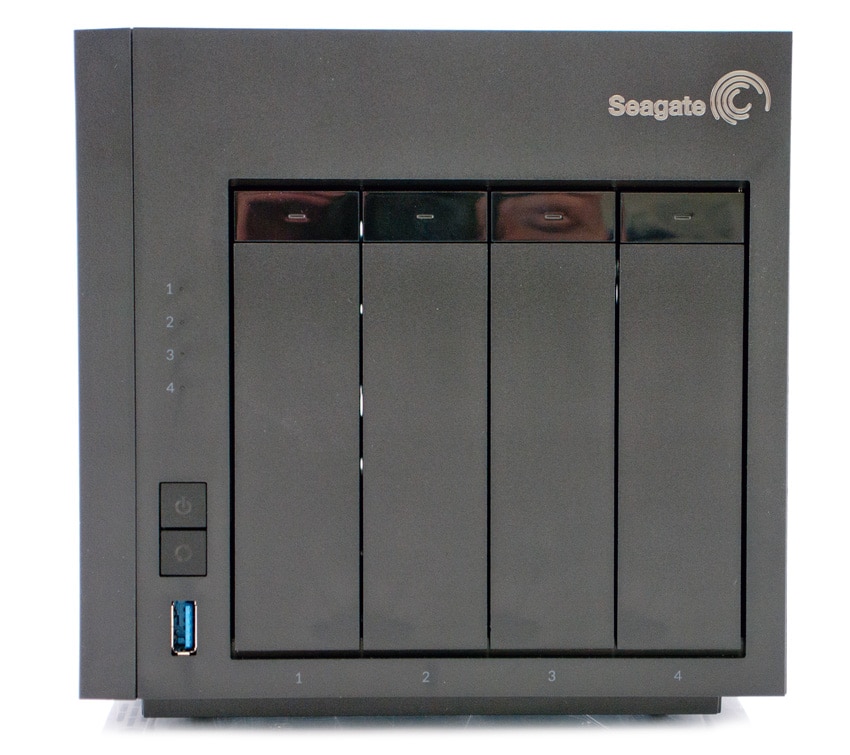
Flipping over to the rear of the device, the fan dominates most of the space. To the right hand side we see the other USB 3.0 port, both network ports, a recessed reset button, a power adapter, and a Kensington Lock.
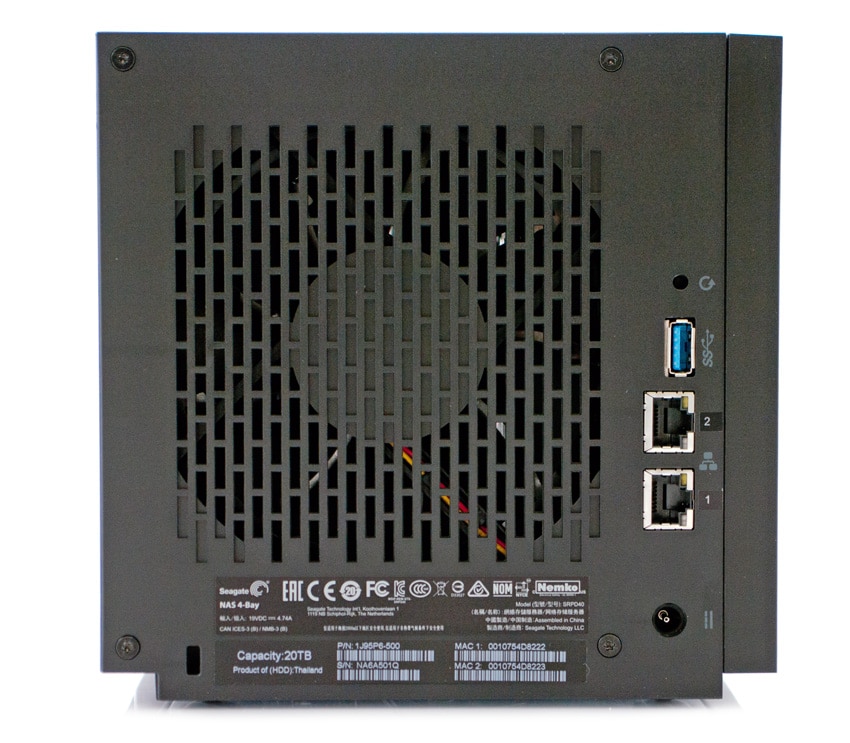
Drive trays for the Seagate NAS are toolless, using a unique side bending mechanism to snap the drives into place. The trays are very well engineered, when swapping drives, having such an easy clip and go design is great. Most other toolless designs still require extra pieces that snap into place.
Usability
The Seagate NAS comes preconfigured with the desired capacity making setup simple for most, though a bare version is available. Connect Ethernet cables, power adapter, and press the power button and you are ready to go. Once you’re logged in, you’ll find a redesigned home screen with icons for Device Manager, File Browser, Download Manager, Backup Manager, and App Manager. The home screen also gives you the option to switch between NAS, restart, or put the device to sleep.
Through Device Manager you can click on the Monitoring tab under Maintenance to see the health of the device, percentage of use of RAM, CPU, network, and fan speed.
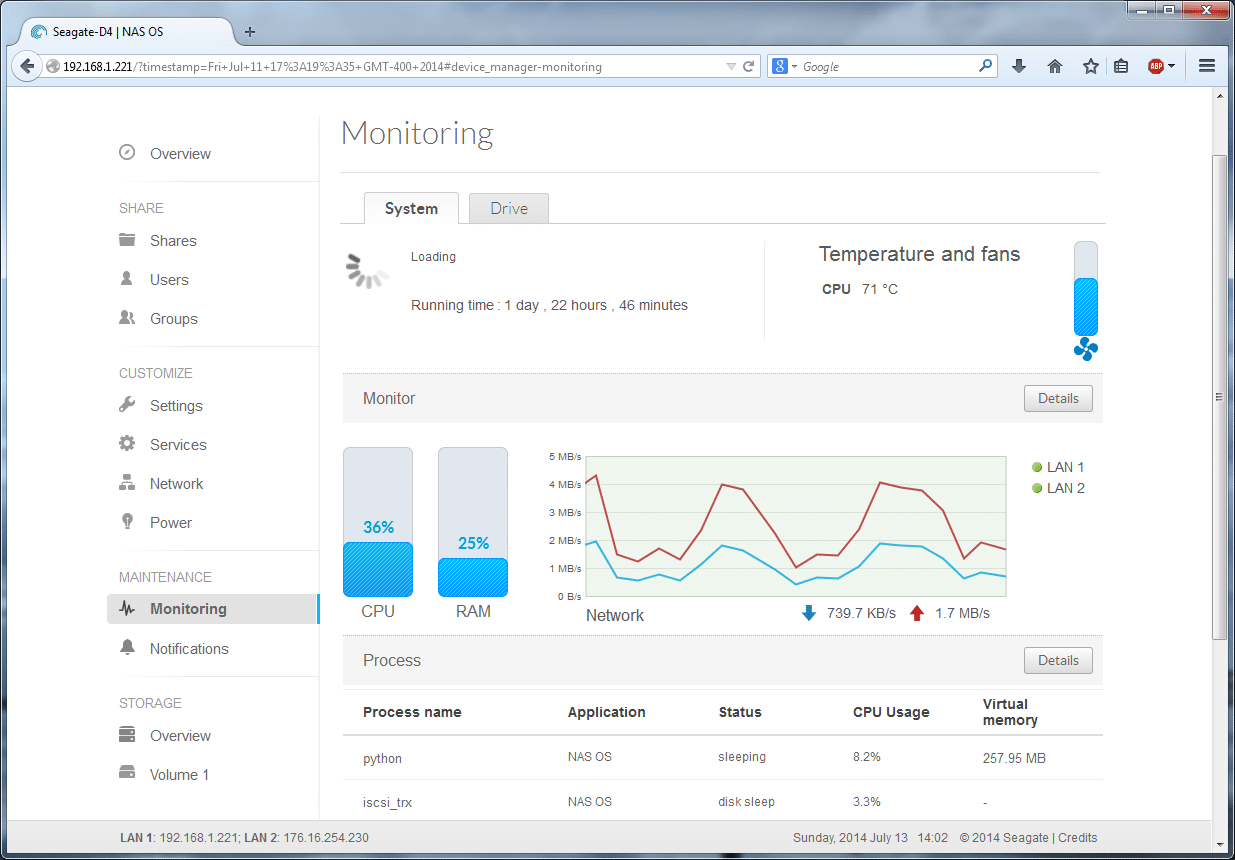
There is also a tab for drives that gives you the total capacity, the temperature, and the SMART status of each drive
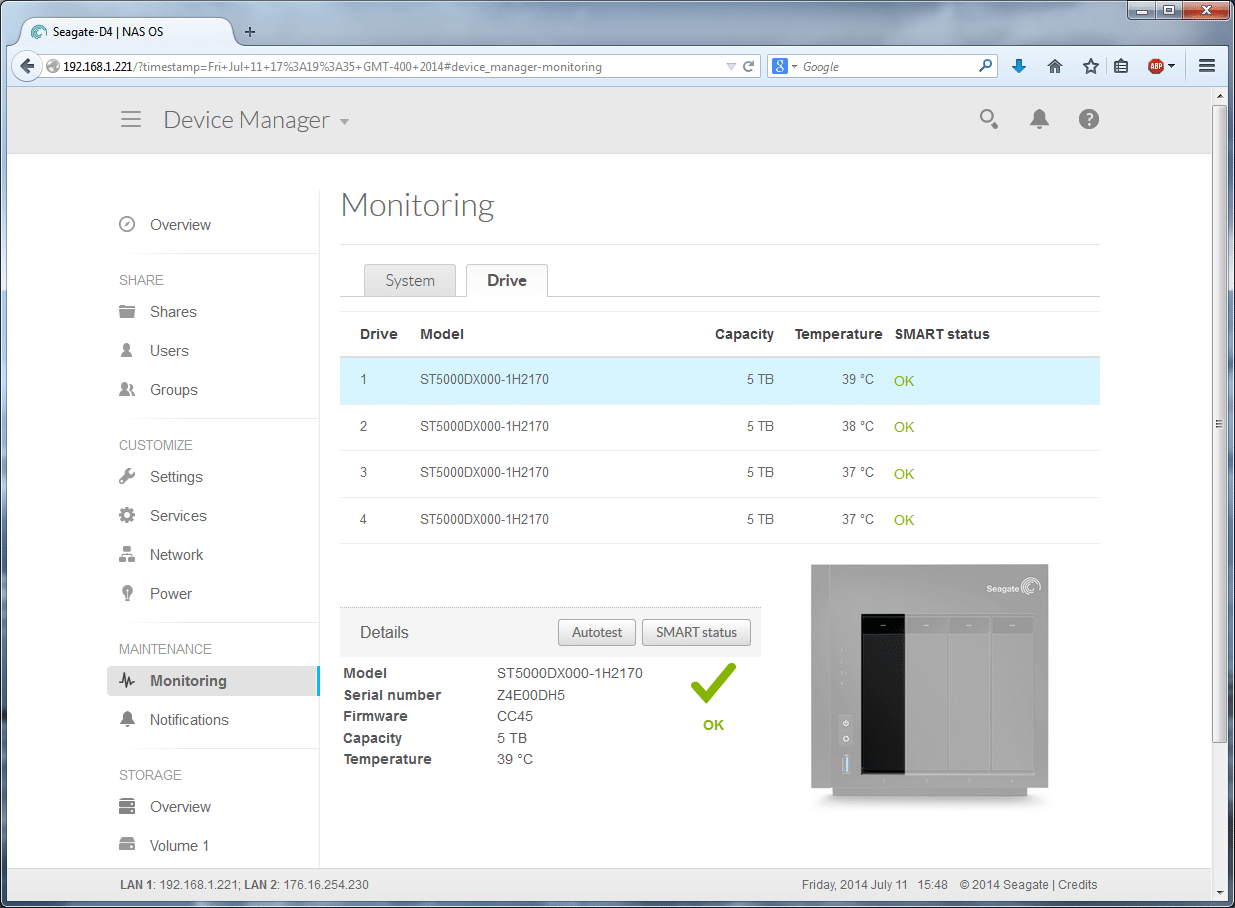
Through the Network tab, you can check network connections, IP addresses, status, and speed.
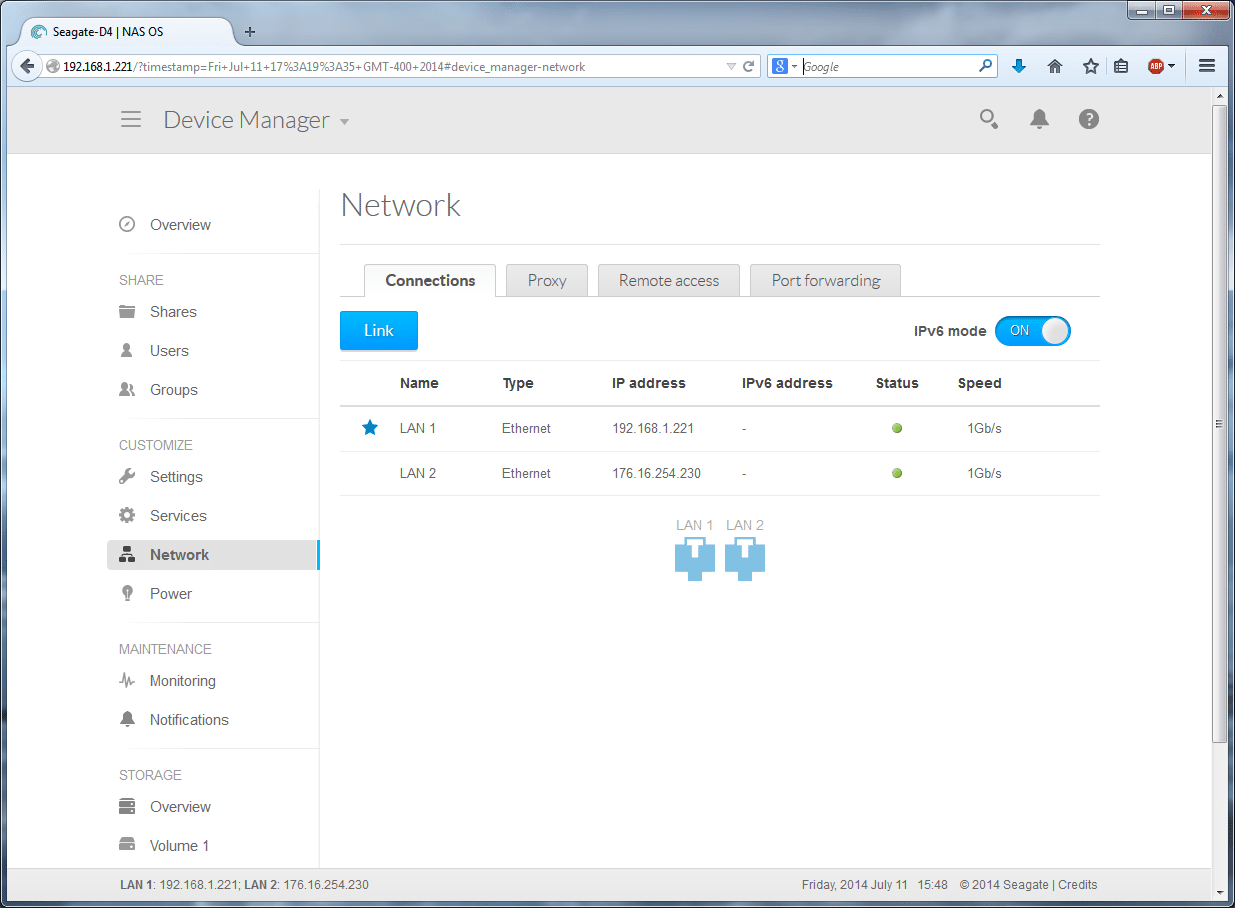
Also under the Network tab you can set up remote access with a custom URL through DynDNS or you can setup Sdrive through the Remote access tab.
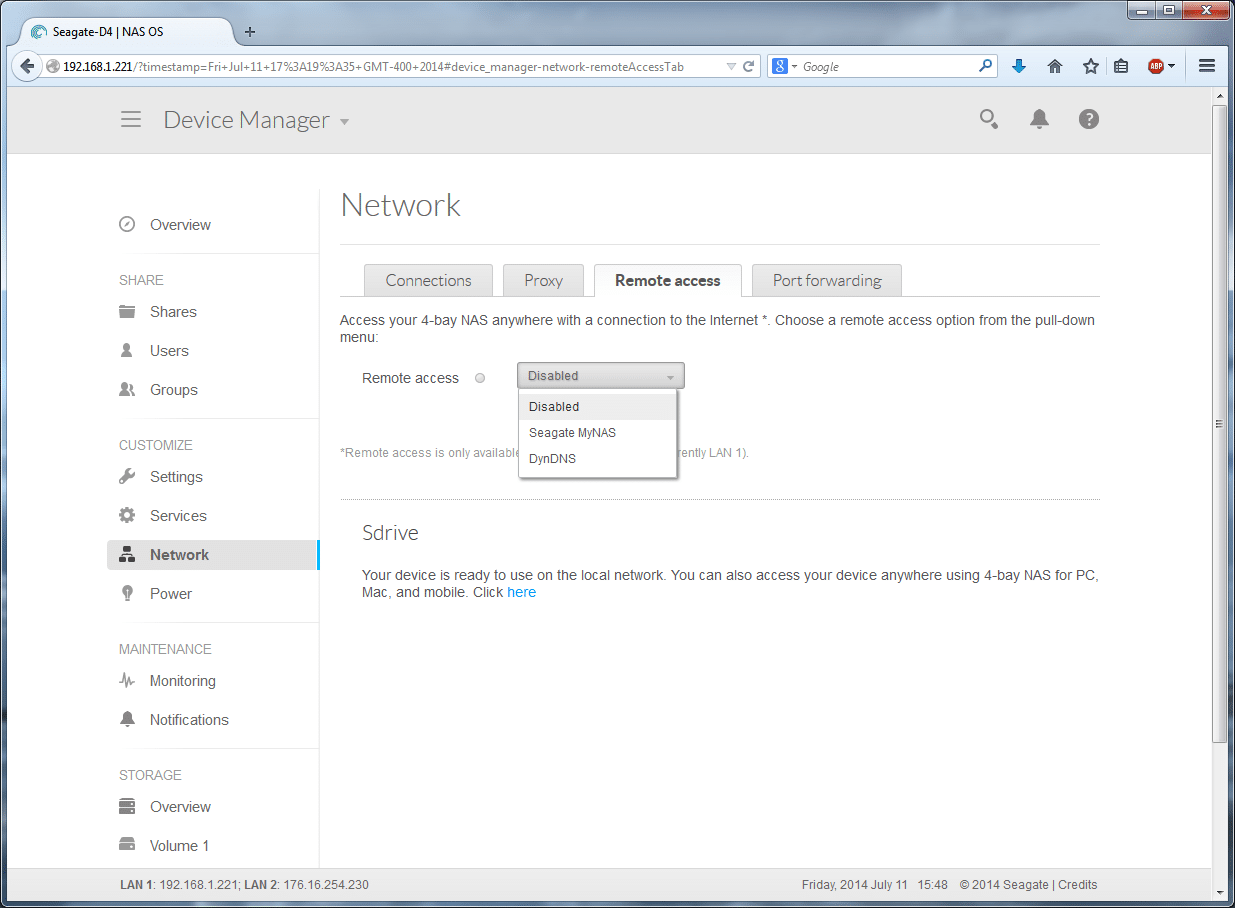
Through the Storage Overview tab in Device Manager, you can check on available space, total capacity, and RAID Configurations. Here you get a list off all volumes in the NAS including those connected through USB. Volumes can be added through Storage Overview through the manage button. First by selecting the volumes you would like to add:
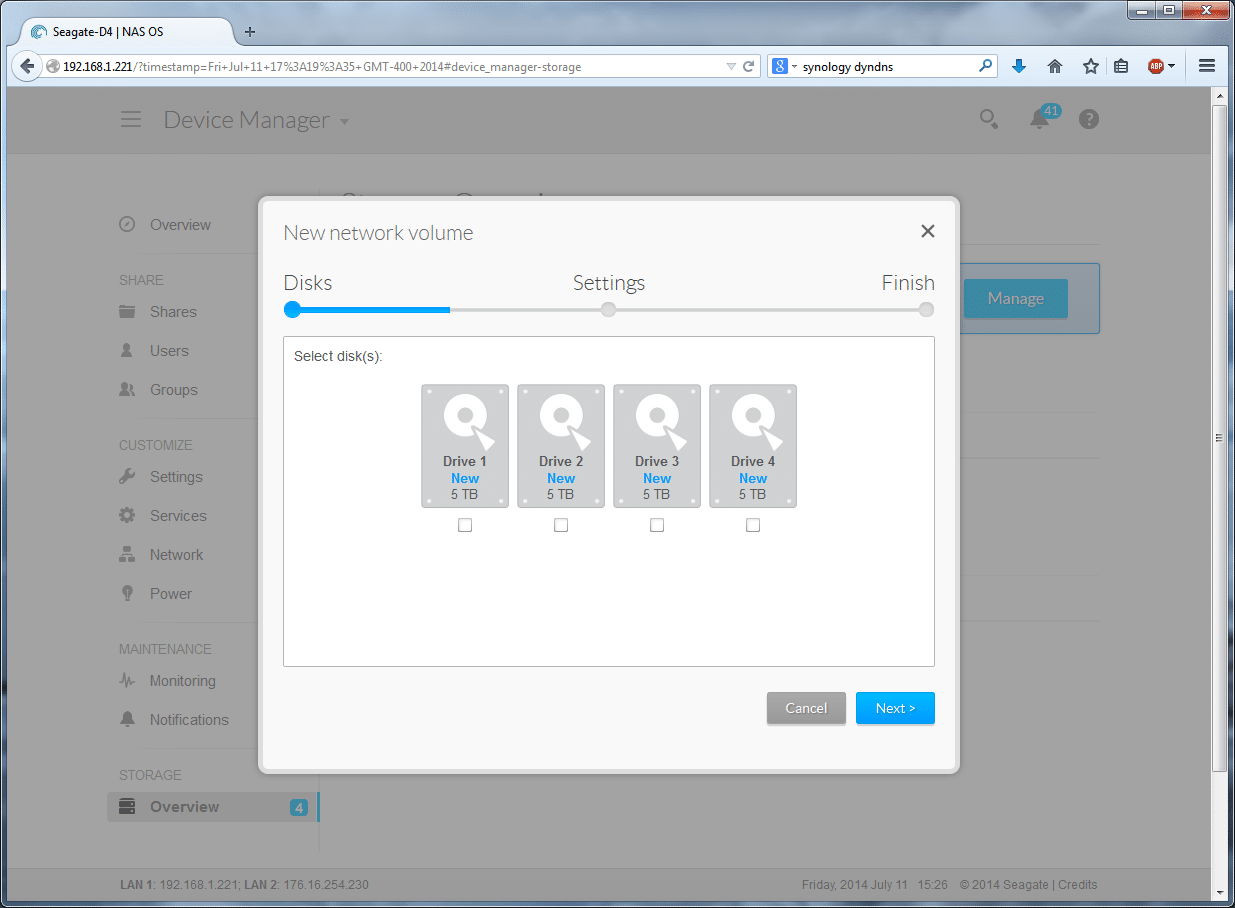
Select whether or not you would like to encrypt the selected volumes:
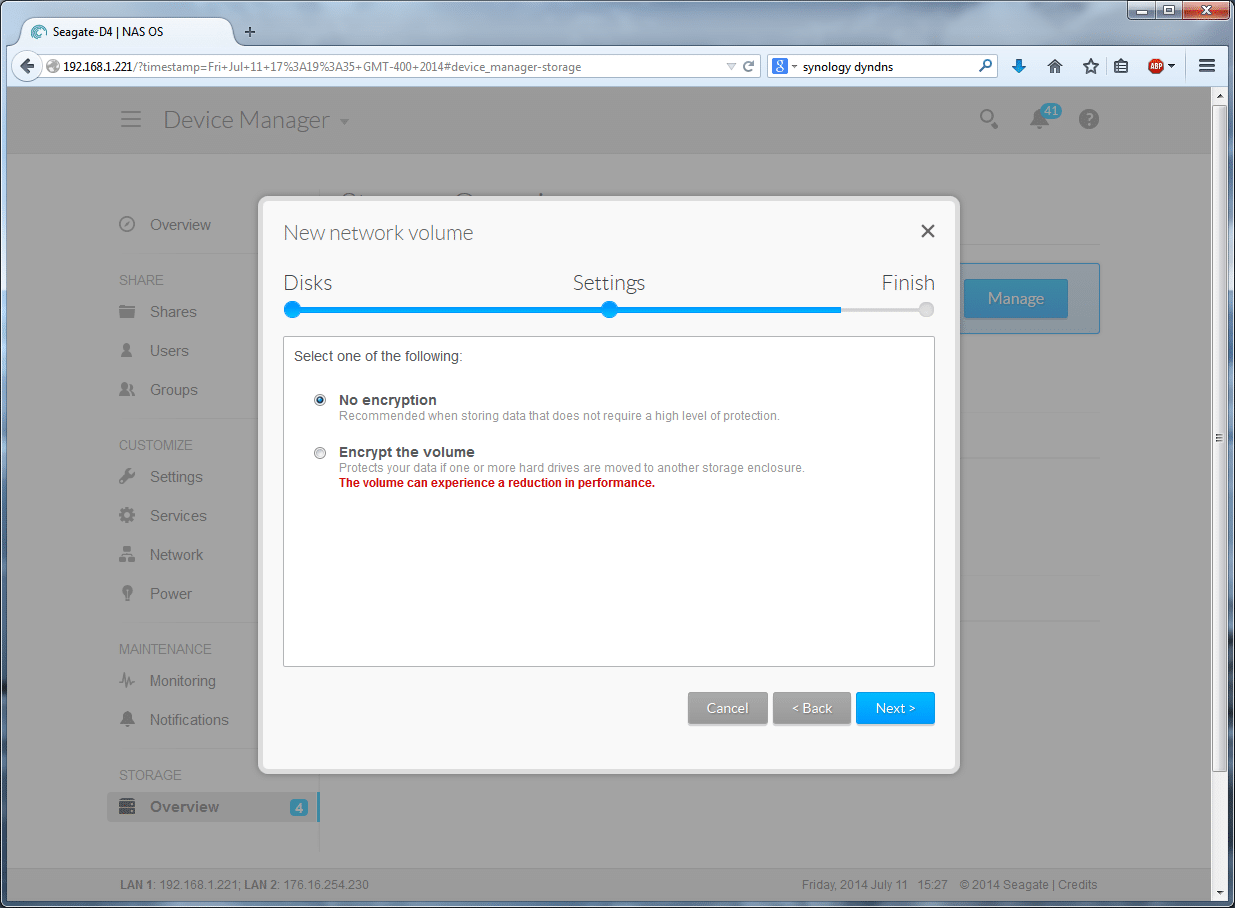
And then RAID can be configured using SimpleRAID or by choosing the desired RAID:
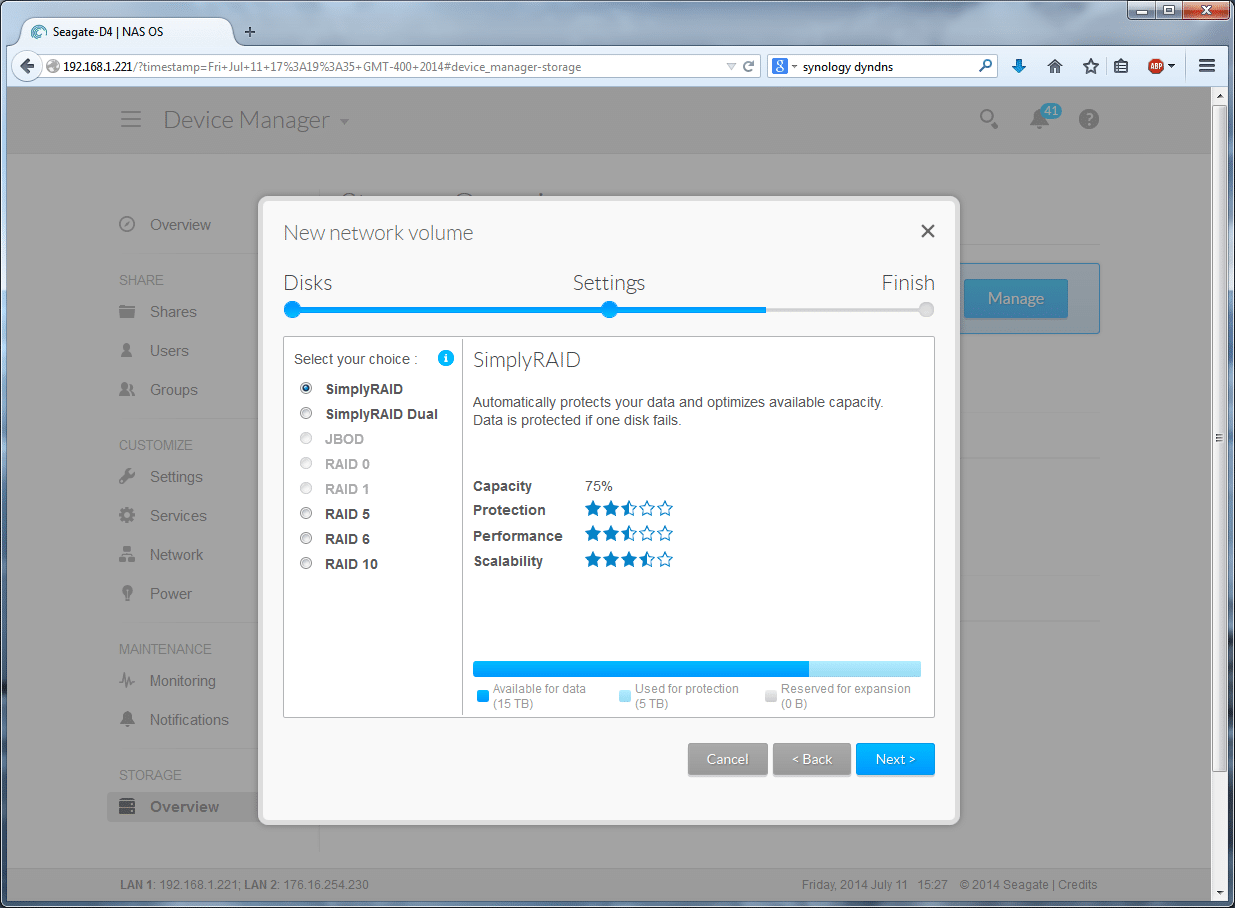
The NAS OS 4 has a few other features: through the Device Manager you can use the Services tab to make the device compatible with your devices on your network. Through Backup Manager, you can schedule various backups, restore from an existing backup, and do a network backup to another NAS OS device or cloud backup. App Manager allows you to download Seagate and third party apps. With File Browser you can view, upload, and download your various files. And Download Manager allows for easy downloads directly to your NAS.
Performance
We tested both CIFS/SMB and iSCSI performance in the Seagate NAS using 4TB Seagate NAS 3.5" drives, which are suited for operation in NAS environments and the close to the 5TB Seagate NAS HDDs the new NAS line ships with. We also compared the Seagate NAS to the Synology DS414j and the Synology DS414, which we tested both CIFS/SMB and iSCSI performance with the WD Red 4TB.
Drives tested for this review:
- RAID1 CIFS/SMB
- RAID1 iSCSI
In order to fairly evaluate the performance of the Seagate NAS we need an environment that ensures that the NAS is the I/O bottleneck rather than the network. Therefore this review employs a Lenovo ThinkServer RD240 running multiple Windows Server 2012 VMs in an ESXi 5.1 environment connected via a quad-port Intel i350-T4 NIC through a Netgear ProSafe GS752TXS switch.
- 2 x Intel Xeon X5650 (2.66GHz, 12MB Cache)
- Windows Server 2008 Standard Edition R2 SP1 64-Bit running on VMware ESXi 5.1
- Intel 5500+ ICH10R Chipset
- Memory – 32GB (4 x 8GB) 1333Mhz DDR3 Registered RDIMMs
Netgear ProSafe GS752TXS Smart 52-port Switch
- 48 1GbE Ports, 4 10GbE SFP+ Uplink Ports
- 176Gbps Aggregate Bandwidth
- Enterprise Synthetic Workload Analysis
Our shared storage benchmark process preconditions each NAS into steady-state with the same workload the device will be tested with under a heavy load of 16 threads with an outstanding queue of 16 per thread, and then tested in set intervals in multiple thread/queue depth profiles to show performance under light and heavy usage. Since HDD-based shared storage reaches its rated performance level very quickly, we only graph out the main sections of each test.
Preconditioning and Primary Steady-State Tests:
- Throughput (Read+Write IOPS Aggregate)
- Average Latency (Read+Write Latency Averaged Together)
- Max Latency (Peak Read or Write Latency)
- Latency Standard Deviation (Read+Write Standard Deviation Averaged Together)
Our Enterprise Synthetic Workload Analysis includes four profiles based on real-world tasks. These profiles have been developed to make it easier to compare to our past benchmarks as well as widely-published values such as max 4k read and write speed and 8k 70/30, which is commonly used for enterprise drives.
- 4k
- 100% Read or 100% Write
- 100% 4k
- 8k 70/30
- 70% Read, 30% Write
- 100% 8k
- 8k (Sequential)
- 100% Read or 100% Write
- 100% 8k
- 128k (Sequential)
- 100% Read or 100% Write
- 100% 128k
In the first of our workloads, we measured a long sample of random 4k performance with 100% write and 100% read activity to get our main results. The top read performer was the WD Red iSCSI in the DS414 followed by the WD Red iSCSI in the DS414j. With write performance we saw the Seagate NAS CIFS/SMB come out on top with a write performance of 530IOPS.
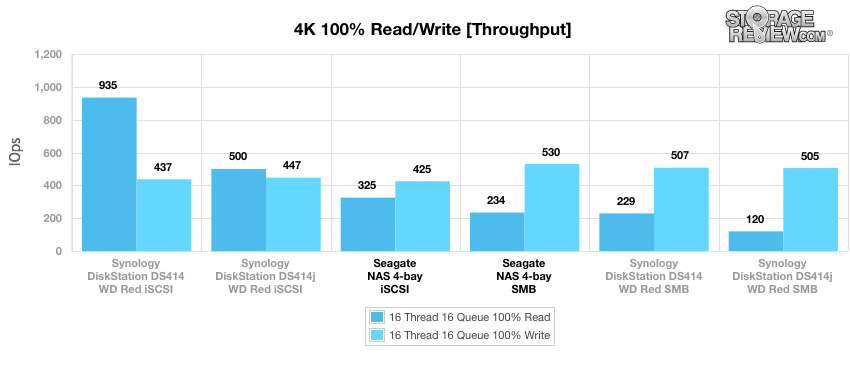
Next we took a look at average latency. With a heavy 16T/16Q load, the results mirrored those above. Again the WD Red iSCSI in the DS414 came out in the lead with the lowest read latency followed by the WD Red iSCSI in the DS414j. And the write latency saw the Seagate NAS CIFS/SMB come out on top with a write speed of 487.42ms.
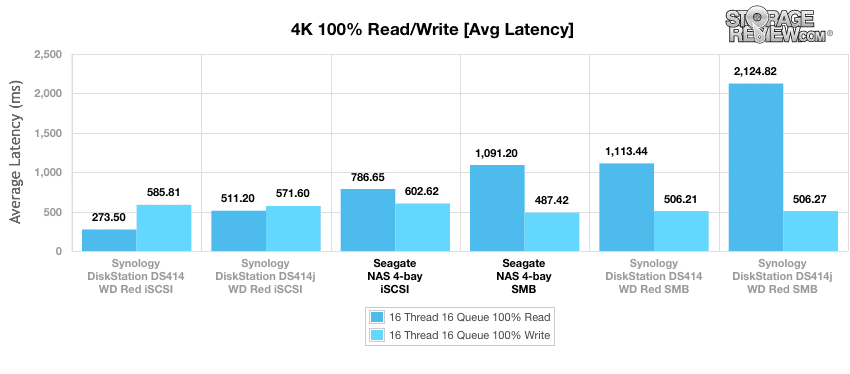
Comparing max latency between the three NAS units, we see the Seagate NAS CIFS/SMB came in second on read performance with a speed of 1,514ms and the Seagate NAS iSCSI came in second on write performance with a speed of 2,463.2ms. Overall the Synology DS414j WD Red iSCSI was the top performer.
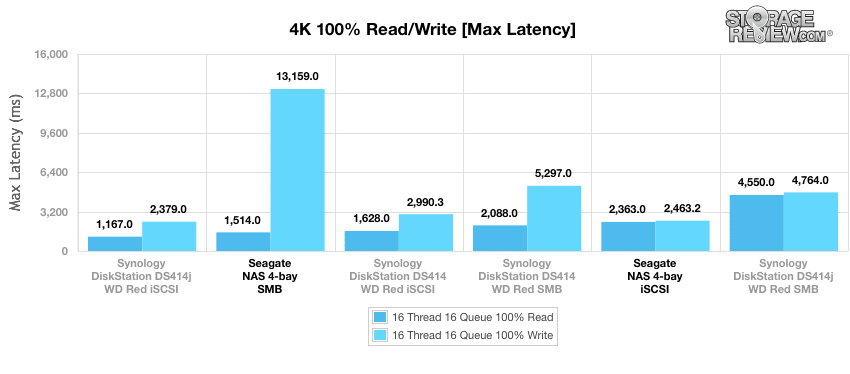
Plotting out our standard deviation in 4k consistency we see similar results to the above the Seagate NAS CIFS/SMB come in second on read performance with a speed of 83.6ms and the Seagate NAS iSCSI came in second on write performance with a speed of 420.72ms. Again the Synology DS414j WD Red iSCSI was the top performer.
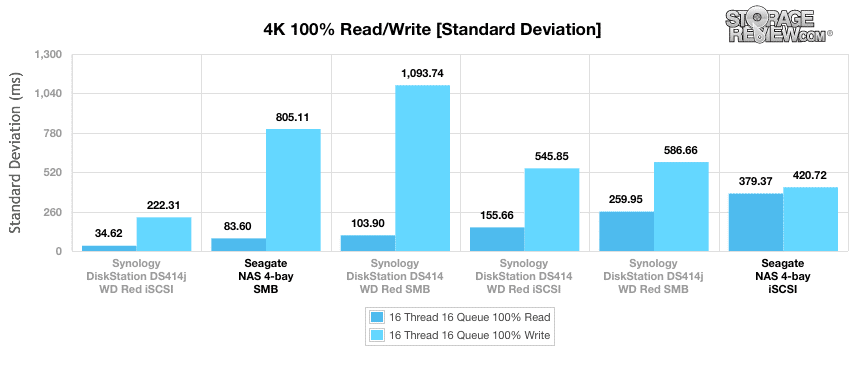
Our next benchmark measures 100% 8k sequential throughput with a 16T/16Q load in 100% read and 100% write operations. The results are very similar to what we saw with the 4k throughput test above. The Seagate NAS CIFS/SMB and iSCSI came in relatively close to one another: the iSCSI having a write performance of 3,319IOPS and a read performance of 3,999IOPS and the CIFS/SMB had a write performance of 3,891IOPS and a read performance of 4,933IOPS. Overall the top performer was the Synology DS414 WD Red CIFS/SMB.
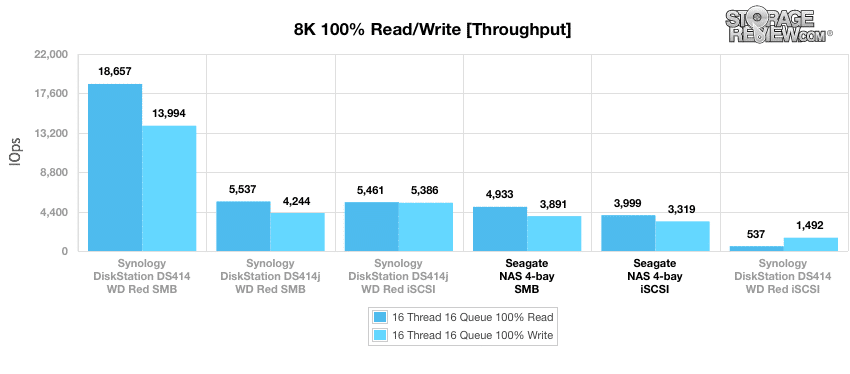
Compared to the fixed 16 thread, 16 queue max workload we performed in the 100% 4k write test, our mixed workload profiles scale the performance across a wide range of thread/queue combinations. In these tests, we span workload intensity from 2 threads and 2 queue up to 16 threads and 16 queue. In the expanded 8k 70/30 test, both the CIFS/SMB and iSCSI Seagate NAS ran about in the middle of the pack peaking at 259IOPS and 385IOPS respectively.
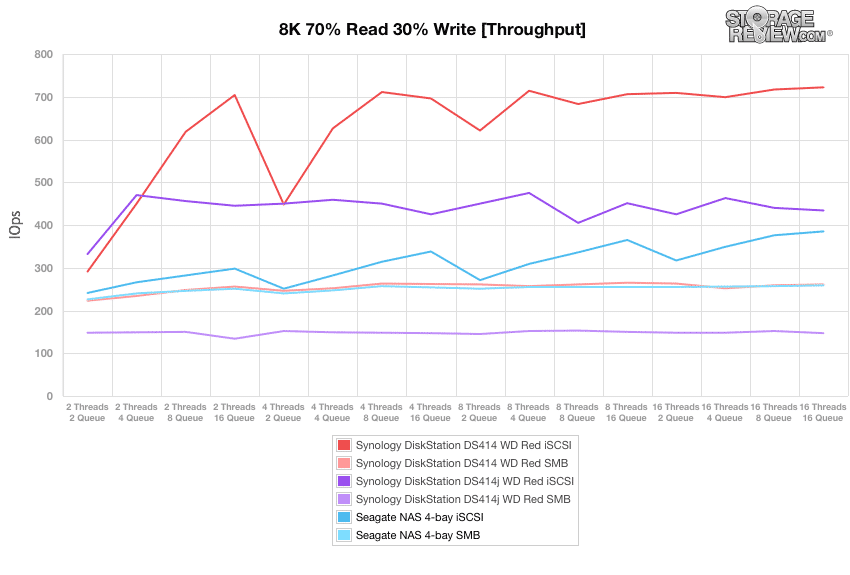
With the 8k 70/30 average response times, again the Seagate NAS ran in the lower to middle of the pack.
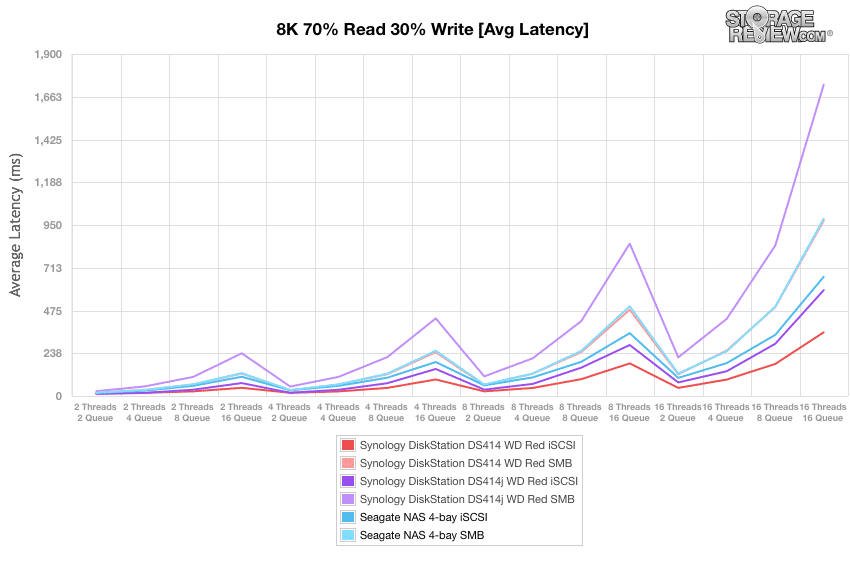
With max latency, we see the Seagate NAS drop to lower end of the pack as the speeds go up.
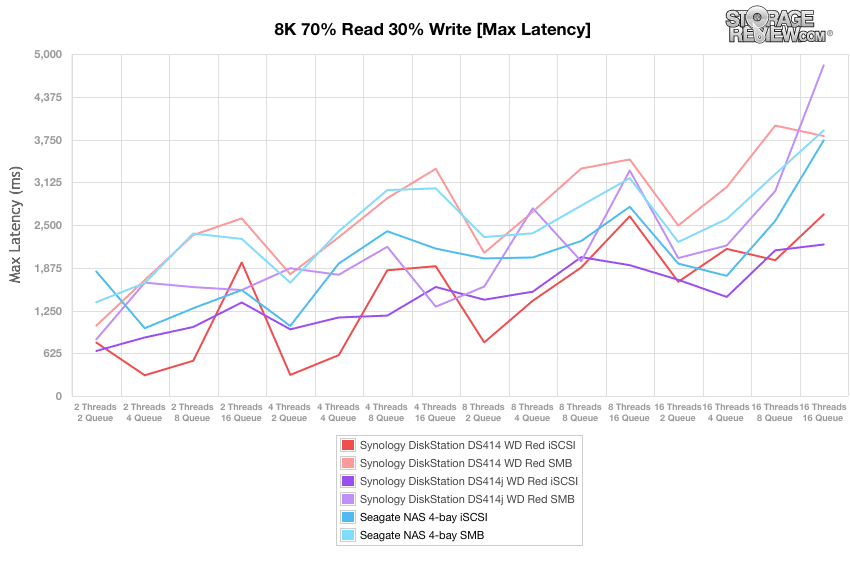
For the entirety of the thread/queue spectrum, the Seagate NAS ran near to last with some of the highest speeds for both CIFS/SMB and iSCSI.
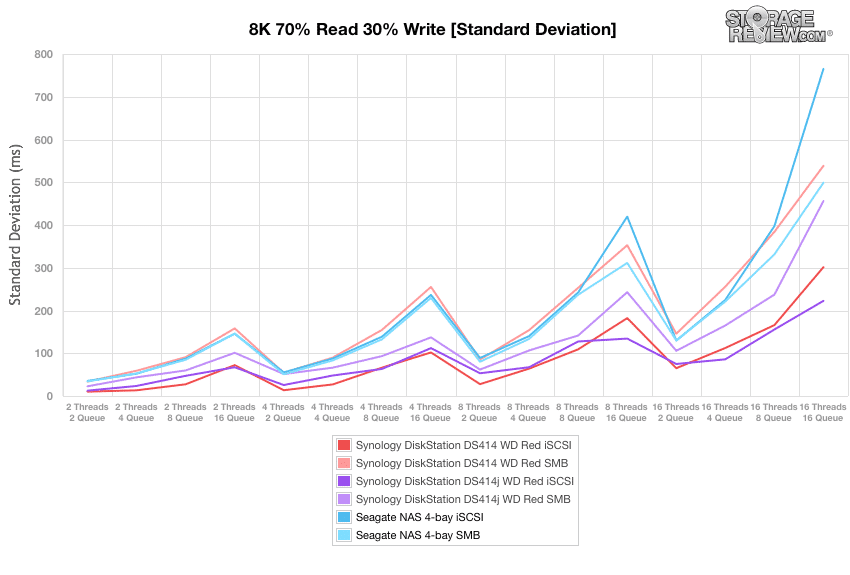
The last test in our small NAS Synthetic Workload testing is the 128k test, which is a large block sequential test that shows the highest sequential transfer speed. Looking at the 128k performance of 100% write and 100% read activity, both the CIFS/SMB and iSCSI performance on the Seagate NAS came in last with read speeds of 26MB/s and 27MB/s respectively and write speeds of 75MB/s and 47MB/s respectively. The DS414 WD Red CIFS/SMB was the top read performer with a speed of 231MB/s and DS414 WD Red iSCSI was the top write performer with a speed of 115MB/s.
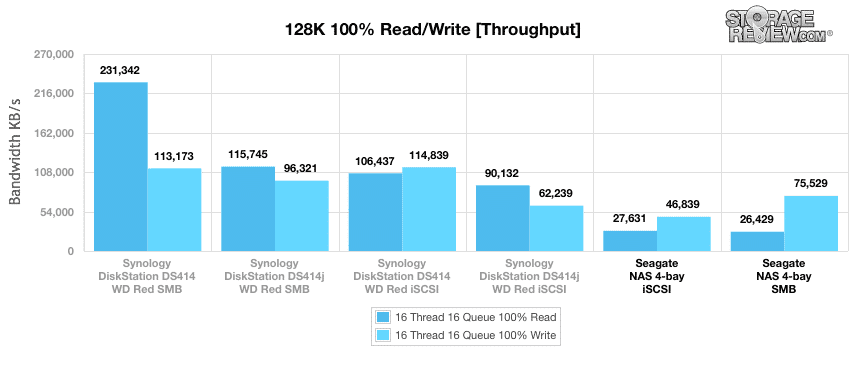
Conclusion
The Seagate NAS line is a desktop form factor NAS aimed at home users and SOHO with no IT infrastructure. It comes with a Marvell 1.2GHz processor, 512 MB DDR3 ram, and can run up to 20TB in capacity. The device runs the new operating system NAS OS 4, which is designed for simplification and ease-of-use. The Seagate NAS ships with the Seagate NAS HDDs, meaning everything from the software, hardware, and drives are all made by Seagate and designed to work together well.
We measured both CIFS/SMB and iSCSI performance in the Seagate NAS and compared it to two other SOHO NASs in a similar price category, the Synology DS414 and the Synology DS414j. We found random 4K access performance to top at 325 IOPS read and 530 IOPS write and 8K performances topping at 4,933 IOPS read and 3,891 IOPS write. And we found the device to have large-block sequential speeds at 27MB/s read and 76MB/s write. Overall it wasn't a strong performer compared to the Synology units, however the Seagate NAS line is designed to be simple to use right out of the box for SOHO. The NAS line is less about dazzling speeds and performance and more about ease-of-use for businesses with no IT resources. On that score the Seagate NAS does well, it's dead simple to use and the UI is clean and intuitive.
Pros
- Hot-swappable, toolless disk trays
- Simple setup and easy to use
- Software, hardware, and drives all made by Seagate
Cons
- Not the strongest performer
Bottom Line
The Seagate NAS line is a small desktop NAS that is easy to use right out of the box, and has enough power and capacity for most SOHOs.
Seagate NAS at Amazon



 Amazon
Amazon